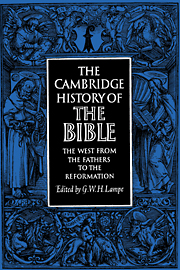Book contents
- Frontmatter
- I The Old Testament: Manuscripts, Text and Versions
- II The History of the Text and Canon of the New Testament to Jerome
- III Early Christian Book-Production: Papyri and Manuscripts
- IV Jerome
- V The Medieval History of the Latin Vulgate
- VI The Exposition and Exegesis of Scripture
- VII The ‘People's Bible’: Artists and Commentators
- VIII Bible Illustration in Medieval Manuscripts
- IX The Vernacular Scriptures
- X Erasmus in Relation to the Medieval Biblical Tradition
- Bibliography
- Notes on the Plates
- Index
- References
VI - The Exposition and Exegesis of Scripture
Published online by Cambridge University Press: 28 March 2008
- Frontmatter
- I The Old Testament: Manuscripts, Text and Versions
- II The History of the Text and Canon of the New Testament to Jerome
- III Early Christian Book-Production: Papyri and Manuscripts
- IV Jerome
- V The Medieval History of the Latin Vulgate
- VI The Exposition and Exegesis of Scripture
- VII The ‘People's Bible’: Artists and Commentators
- VIII Bible Illustration in Medieval Manuscripts
- IX The Vernacular Scriptures
- X Erasmus in Relation to the Medieval Biblical Tradition
- Bibliography
- Notes on the Plates
- Index
- References
Summary
TO GREGORY THE GREAT
The ways in which the Bible was interpreted by the Church of the first six centuries had already been partly determined by the Christian communities of the apostolic age itself. From the earliest stage to which the tradition of the Church can be traced, the Scriptures of the Old Testament had been interpreted as a book about Christ. The decisive act of God in human history had taken place; the Gospel events stood as the central and focal point of God's dealings with mankind. The promises to Israel, and the long chain of events in which, according to the Scriptures, these promises were worked out in divine judgements and in saving acts of mercy and deliverance, had reached their fulfilment in the life, death and Resurrection of Christ. This fulfilment could only be apprehended as such in the light of the ancient promises and the entire course of Israel's history, as this had been interpreted in the prophetic-historical tradition of the Old Testament. Conversely, the Scriptures could be rightly understood only when they were seen in the new perspective of the age of fulfilment which had now dawned. God had so acted in Christ that the focal point of history, which gave meaning to the whole process, no longer lay in the remote past, in the deliverance from Egypt, the Sinai Covenant and the entry into the Promised Land. A greater exodus had taken place, a new covenant had been established, and the promised age of the Spirit, the last days foretold by the prophets, had now begun.
- Type
- Chapter
- Information
- The Cambridge History of the Bible , pp. 155 - 279Publisher: Cambridge University PressPrint publication year: 1969
References
- 1
- Cited by

